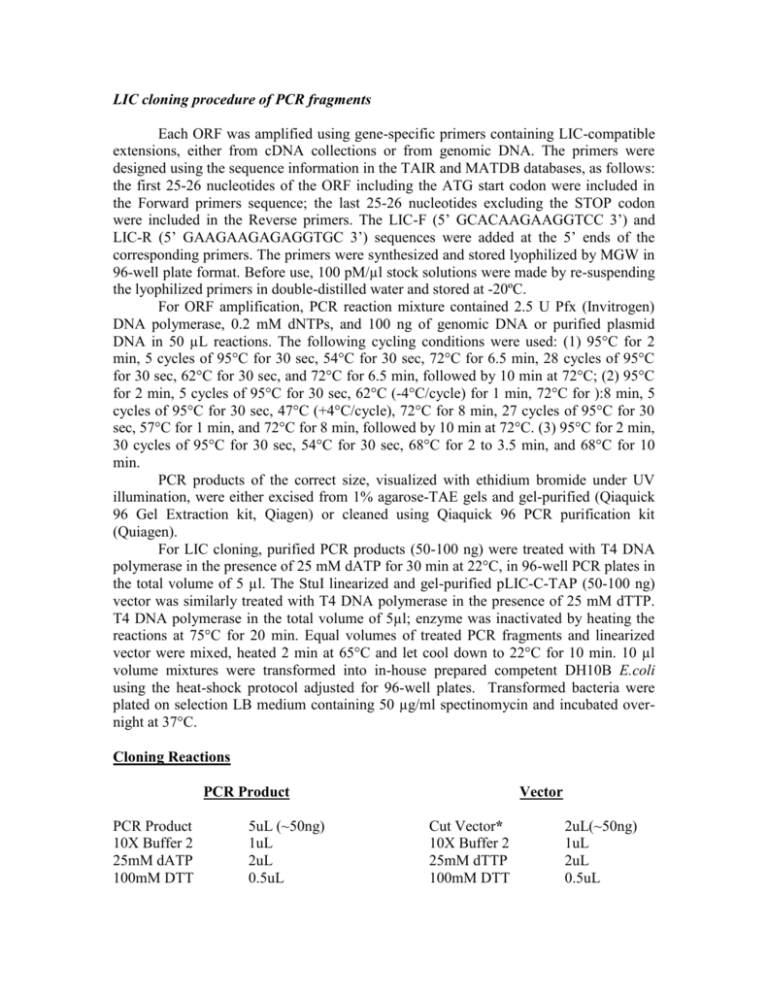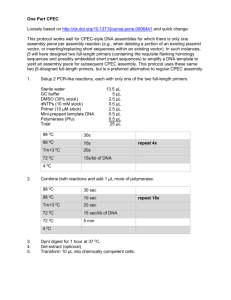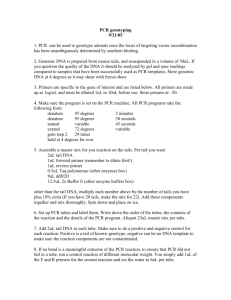LIC cloning procedure - Dinesh
advertisement

LIC cloning procedure of PCR fragments Each ORF was amplified using gene-specific primers containing LIC-compatible extensions, either from cDNA collections or from genomic DNA. The primers were designed using the sequence information in the TAIR and MATDB databases, as follows: the first 25-26 nucleotides of the ORF including the ATG start codon were included in the Forward primers sequence; the last 25-26 nucleotides excluding the STOP codon were included in the Reverse primers. The LIC-F (5’ GCACAAGAAGGTCC 3’) and LIC-R (5’ GAAGAAGAGAGGTGC 3’) sequences were added at the 5’ ends of the corresponding primers. The primers were synthesized and stored lyophilized by MGW in 96-well plate format. Before use, 100 pM/µl stock solutions were made by re-suspending the lyophilized primers in double-distilled water and stored at -20ºC. For ORF amplification, PCR reaction mixture contained 2.5 U Pfx (Invitrogen) DNA polymerase, 0.2 mM dNTPs, and 100 ng of genomic DNA or purified plasmid DNA in 50 µL reactions. The following cycling conditions were used: (1) 95°C for 2 min, 5 cycles of 95°C for 30 sec, 54°C for 30 sec, 72°C for 6.5 min, 28 cycles of 95°C for 30 sec, 62°C for 30 sec, and 72°C for 6.5 min, followed by 10 min at 72°C; (2) 95°C for 2 min, 5 cycles of 95°C for 30 sec, 62°C (-4°C/cycle) for 1 min, 72°C for ):8 min, 5 cycles of 95°C for 30 sec, 47°C (+4°C/cycle), 72°C for 8 min, 27 cycles of 95°C for 30 sec, 57°C for 1 min, and 72°C for 8 min, followed by 10 min at 72°C. (3) 95°C for 2 min, 30 cycles of 95°C for 30 sec, 54°C for 30 sec, 68°C for 2 to 3.5 min, and 68°C for 10 min. PCR products of the correct size, visualized with ethidium bromide under UV illumination, were either excised from 1% agarose-TAE gels and gel-purified (Qiaquick 96 Gel Extraction kit, Qiagen) or cleaned using Qiaquick 96 PCR purification kit (Quiagen). For LIC cloning, purified PCR products (50-100 ng) were treated with T4 DNA polymerase in the presence of 25 mM dATP for 30 min at 22°C, in 96-well PCR plates in the total volume of 5 µl. The StuI linearized and gel-purified pLIC-C-TAP (50-100 ng) vector was similarly treated with T4 DNA polymerase in the presence of 25 mM dTTP. T4 DNA polymerase in the total volume of 5µl; enzyme was inactivated by heating the reactions at 75°C for 20 min. Equal volumes of treated PCR fragments and linearized vector were mixed, heated 2 min at 65°C and let cool down to 22°C for 10 min. 10 µl volume mixtures were transformed into in-house prepared competent DH10B E.coli using the heat-shock protocol adjusted for 96-well plates. Transformed bacteria were plated on selection LB medium containing 50 µg/ml spectinomycin and incubated overnight at 37°C. Cloning Reactions PCR Product PCR Product 10X Buffer 2 25mM dATP 100mM DTT 5uL (~50ng) 1uL 2uL 0.5uL Vector Cut Vector* 10X Buffer 2 25mM dTTP 100mM DTT 2uL(~50ng) 1uL 2uL 0.5uL T4 DNA Polymerase 0.2uL Water 1.3uL Total 10uL Cloning Steps Incubate at 22C for 30 minutes Incubate at 75C for 20 minutes Cool for 2-3 minutes Mix 10uL PCR Product Reaction 10uL Vector Reaction Incubate at 65C for 2 minutes Incubate at 22C for 10 minutes Transform into E. coli DH10B cells *NOTE: Cut pLIC-C-TAP with Stu1 Enzyme T4 DNA Polymerase 0.2uL Water 4.3uL Total 10uL








